Esther
God Uses a Beautiful Young Woman to Save Israel
Central Teaching
God works behind the scenes through a beautiful young woman to deliver his people from annihilation.
Memory Verse
Setting
The story of Esther takes place in the Persian capital city of Susa, the same city that Nehemiah is residing in at the beginning of the book of Nehemiah. The story of Esther, however, takes place earlier than the story of Nehemiah, during the reign of the Persian King Xerxes (485–465 BC). Xerxes is referred to as Ahasuerus in the Hebrew text, as well as in some English translations. Nehemiah’s story takes place during the reign of the following king, Artaxerxes.

Gold signet ring from Egypt. The king’s signet ring is mentioned four times in Esther (3:10; 8:2, 8, 10).
Message
The book of Esther contains some unusual features that affect how we determine the message. First, the name of God is never mentioned in the entire book of Esther. Second, none of the characters pray or inquire of God. While Esther does partake of a three-day fast, she never actually mentions God or prays to him (as Ezra and Nehemiah did repeatedly). In fact, none of the characters appear to express specific faith in God, in strong contrast to Ezra and Nehemiah.
What’s more, the names of the main characters are disturbing. Mordecai means “man of Marduk.” Marduk was the primary god of the Babylonians, making this an alarming name for an Israelite hero. Similarly, the name Esther is derived from Ishtar, the Mesopotamian goddess of love. The meaning of the names, of course, is not conclusive for determining the meaning of the story; but names often do play a role, and these particular names are especially disconcerting. Thus it is doubtful that the author of Esther intended for us to see Mordecai and Esther as models of faith.

These bottles held eye makeup, which was applied with a metal rod.
Rather, the book of Esther teaches us that even though the Jews who remained in Persia were not strong in their faith, God in his grace worked powerfully behind the scenes to deliver them from annihilation anyway. Mordecai and Esther are certainly bold and brave, but they do not seem to be faith-driven. As characters, they probably symbolize those Jews who remained in exile and did not try to return to the promised land.
Outline
Interesting Features
- The story of Esther is an enchanting rags-to-riches story.
- The book of Esther also has an evil villain—a classic “bad guy” named Haman.
- Nowhere in the book of Esther is the name of God mentioned. Likewise, no one in Esther prays or mentions any of the covenants, in strong contrast to Ezra and Nehemiah.
- Esther is never quoted in the New Testament.

Carved stone relief from the Persian capital city of Persepolis, depicting a king, probably Xerxes
Connections
While we can certainly learn much from Esther’s bravery, the primary lesson in the book of Esther comes from the actions of God. We see God working quietly behind the scenes to implement his plan. God rescues the Israelites not because of Esther’s piety but because saving them is part of his character and his plan, even though the Jews in Persia are not living obediently. God often works in our lives even when we do not deserve it and is faithful to his promises and to his plan in spite of us. This should give us great encouragement in difficult times.